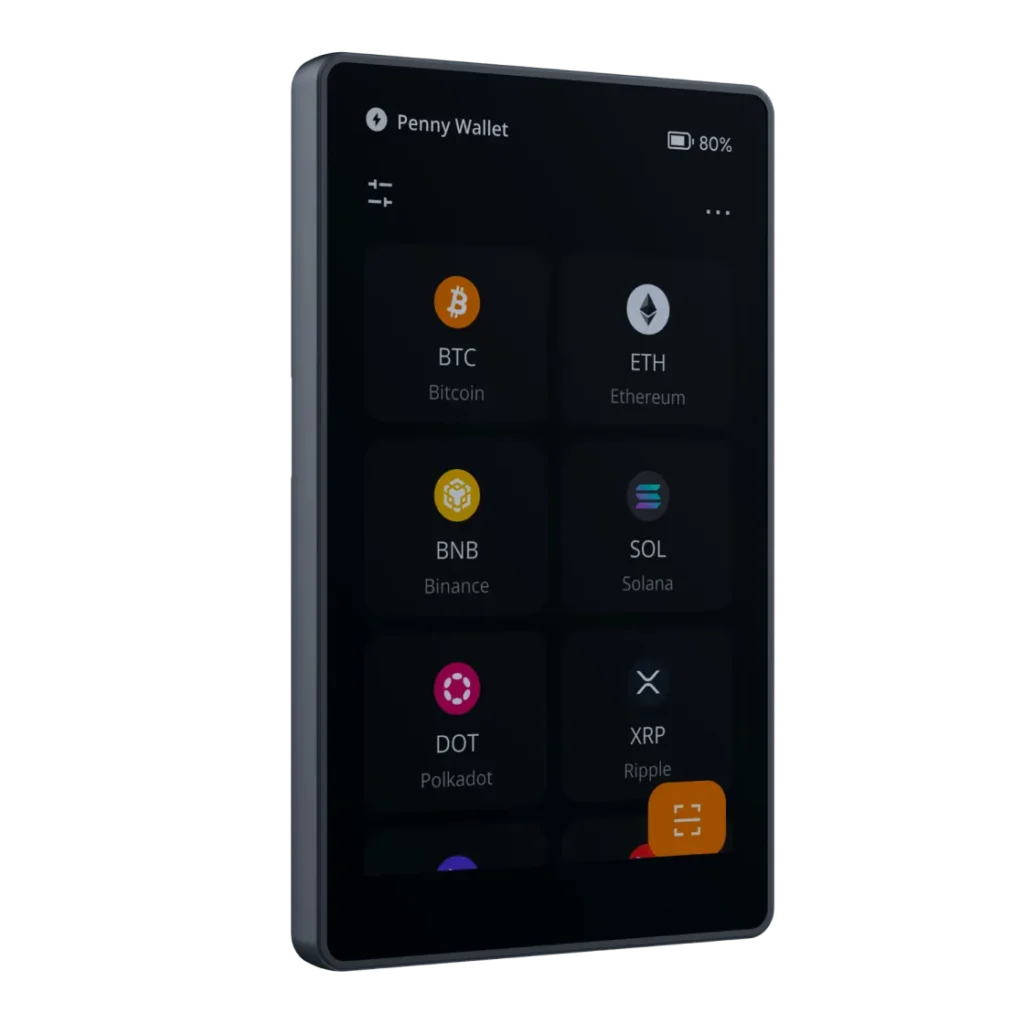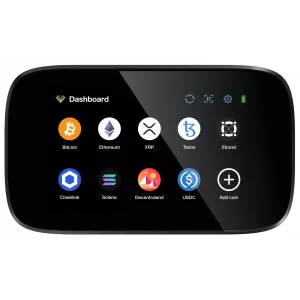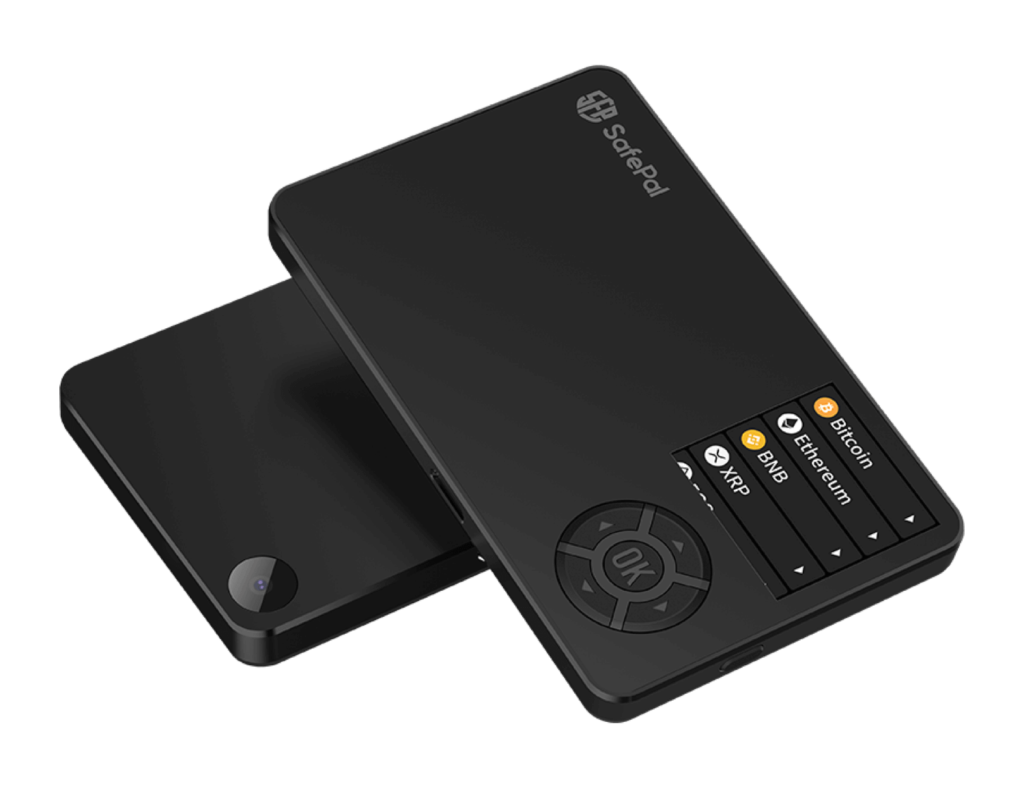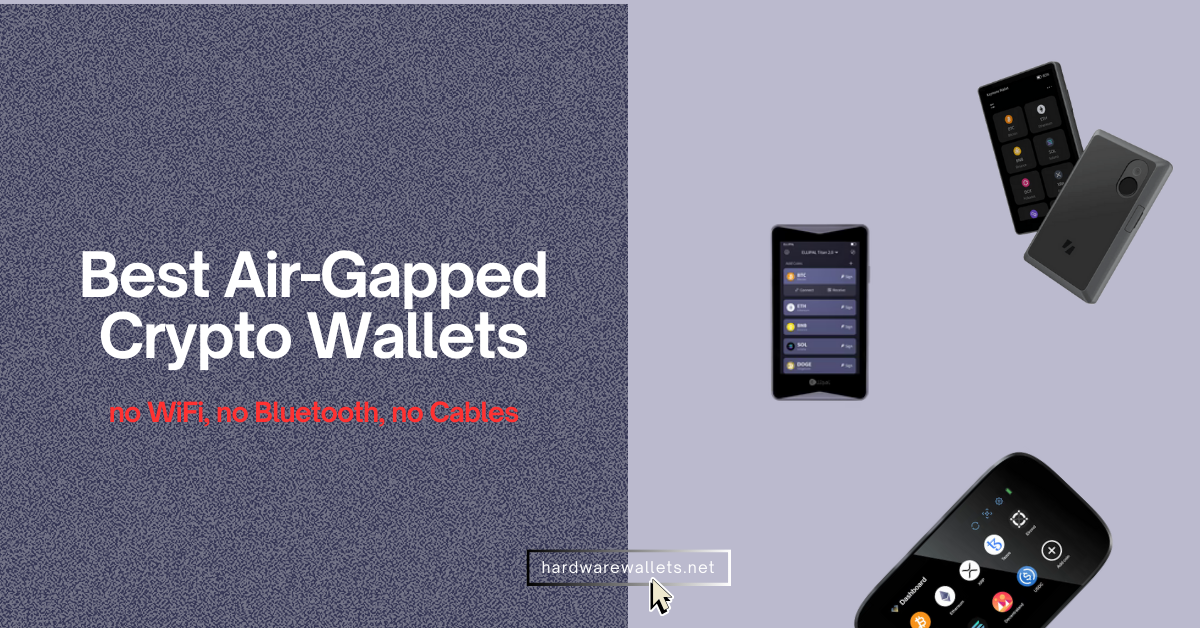I’ve spent the last 5 years rotating through dozens of cold storage wallets, from open‑source devices to credit card-sized NFC wallets. Some were fantastic, some were frustrating, and a few ended up at the bottom of a drawer after a single day.
Eventually, I narrowed my personal rotation down to the 5 best air-gapped crypto wallets that offer a good balance of security, usability, and asset support. They all rely on QR codes or micro‑SD cards to move data and keep your private keys isolated. The is no Bluetooth, WiFi, cellular, or cable support.
My List of Best Air-Gapped Wallets for Crypto Cold Storage
Here’s my list of the best air-gapped cold wallets, chosen through my hands-on testing…
- ELLIPAL Titan 2.0: Best for air-gapped crypto storage (no WiFi, no Bluetooth, no cables)
- Keystone 3 Pro: Best for open-source design
- NGRAVE ZERO: Best for high security (EAL7 OS)
- SafePal S1: Best for budget-conscious users (costs only $49)
- ELLIPAL X Card: Best for portability (credit card-like with NFC tap)
Best Air-Gapped Hardware Wallets Reviewed
The best air-gapped crypto hardware wallets are ELLIPAL Titan 2.0, Keystone 3 Pro, NRAVE Zero, SafePal S1, and ELLIPAL X Card. Here is an in-depth review of each wallet…
1. ELLIPAL Titan 2.0

ELLIPAL Titan 2.0 is my #1 choice as the best air-gapped crypto wallet. It’s built from a titanium alloy and feels more like a premium smartphone than a cheap gadget. Honestly, that heft gave me confidence right away.
The Titan doesn’t have Wi‑Fi, Bluetooth, NFC, or USB data ports. You can charge it via USB, but data never flows through that cable. Every transaction is signed offline and transmitted to your phone using QR codes. That design choice removes obvious attack surfaces like malware on a computer or a compromised cable.
The Titan 2.0 also uses a CC EAL5+ secure element to isolate your seed phrase and protect it against physical extraction. ELLIPAL says it supports more than 10,000 coins and tokens across 40+ blockchains, including all the major chains and many smaller ones. Through the companion app, you can swap tokens, stake some assets, and connect to dApps via WalletConnect.
Drawbacks I Find
- Heavy and bulky: Carrying it in a pocket isn’t convenient. It’s meant for a safe or desk drawer.
- Closed firmware: The code isn’t open source, which might bother purists.
- Pricey: At around $129, it sits at the higher end of hardware wallets.
- QR code fatigue: Signing complex DeFi transactions sometimes requires scanning multiple codes back and forth, which can feel tedious.
Key Features to Know
| Air‑gapped operation | Yes – QR‑code signing only; no Wi‑Fi, Bluetooth, NFC, or USB data |
| Secure element | CC EAL5+ chip |
| Display | 4‑inch IPS color touch screen |
| Supported blockchains | 40+ blockchains, including Bitcoin, Ethereum, and Layer 2s |
| Supported tokens | Over 10,000 coins and tokens |
| Battery | 1,400 mAh rechargeable (around 6 hours of active use) |
| Account management | Up to 10 separate seed or private‑key accounts |
| Compatibility | Android/iOS app, MetaMask, WalletConnect |
| Special security features | Metal body, pin lock, passphrase option, self‑destruct on tamper detection |
2. Keystone 3 Pro

Kestone Pro is another top air-gapped cold wallet with open-source firmware. The company released the firmware under the MIT license and made the hardware designs public. That transparency builds trust; anyone can audit the code and reproduce the device.
For security purposes, the 3 Pro goes a step further by splitting sensitive data across three separate secure elements: one stores your keys, another handles the fingerprint sensor, and the third manages the firmware. That way, a compromise in one component doesn’t expose everything.
The 4‑inch high‑resolution touch screen is sharp, and the fingerprint sensor sits under the power button. Using the 3 Pro feels a lot like handling a small smartphone. Data transfer is done through QR codes or a micro‑SD card.
Unlike the Titan, the battery in the 3 Pro is non‑removable, but it charges via USB‑C and lasts roughly two weeks with occasional use. The wallet also supports Shamir Backup (SLIP39), so you can split your recovery phrase into multiple shares.
Drawbacks I Find
- Non‑removable battery: If the battery fails in a few years, you’ll have to migrate your seed to a new device.
- Micro‑SD requirement: Firmware updates and backups require a micro‑SD card, which you need to buy separately.
- No Bluetooth or Wi‑Fi: Some users may miss wireless convenience, but it’s a deliberate security choice.
- Learning curve: Features like Shamir Backup and multi‑seed management can confuse beginners.
Key Features to Know
| Air‑gapped operation | Yes – QR codes and micro‑SD cards; no Bluetooth or Wi‑Fi |
| Secure elements | Three independent CC EAL5+ chips |
| Display | 4‑inch high‑resolution color touch screen |
| Supported assets | Bitcoin plus 5,000 + altcoins |
| Battery | 1,000 mAh (non‑removable, USB‑C charging) |
| Backup options | Shamir backup, multiple seed phrases |
| Biometric security | Fingerprint authentication |
| Passphrase support | Yes – optional 25th word |
| Open source | Fully open hardware and firmware under MIT license |
3. NGRAVE ZERO

Among all the air-gapped crypto wallets I’ve tested, the NGRAVE ZERO stands out as the most secure and the most expensive. They achieved EAL7 certification for the operating system, which is the highest rating you’ll find on any consumer device. EAL7 means the firmware and hardware have undergone a very rigorous evaluation, far beyond what typical wallets offer.
When you first held the ZERO, it felt like a premium smartphone: it has a 4‑inch color touch screen, an aluminum body, and a fingerprint sensor. Now, what makes the ZERO unique is how it generates and stores your private key.
During setup, it creates what the company calls a “Perfect Key” by combining your fingerprint with environmental entropy, things like light levels and device movement. That randomness, mixed with your biometrics, creates a strong seed phrase.
Transactions on the ZERO are signed entirely offline using QR codes. There’s no USB, Bluetooth, or NFC at all, and the OS is custom‑built.
Drawbacks I Find
- Expensive: At almost $400, it’s out of reach for many users. You’re paying for peace of mind.
- Limited DeFi functionality: The ZERO focuses on cold storage, so you can’t stake or use dApps directly.
- Closed‑source firmware: Some parts of the OS aren’t open, which could bother transparency advocates.
- Size and weight: Though smaller than the Titan, it’s still bigger than card‑style wallets and won’t fit in a standard wallet.
Key Features to Know
| Air‑gapped operation | Yes – QR codes only; no USB, Wi‑Fi, Bluetooth, or NFC |
| Security certification | EAL7 for the operating system |
| Display | 4‑inch color touch screen |
| Supported assets | Over 1,000 cryptocurrencies, including Ethereum NFTs |
| Biometric security | Fingerprint sensor |
| Backup solution | Optional Graphene metal plates (tamper-resistant) |
| Construction | Aluminum alloy body |
| Price | Around $398 (premium segment) |
4. SafePal S1

SafePal S1 is the most affordable air-gapped hardware wallet. It costs only $49. Despite its price, it boasts an EAL6+ secure element and a self‑destruct function. Physically, it’s about the size of a thick credit card. It has a small 1.3‑inch screen and four physical buttons, plus a tiny camera to scan QR codes.
Like the other offline wallets here, there’s no Bluetooth, Wi‑Fi, NFC, or data‑capable USB port. You can easily charge it via micro‑USB, but the cable doesn’t carry transaction data.
SafePal wallet works with more than 200 blockchains and an unlimited number of tokens, from Bitcoin and Ethereum to obscure BEP‑20 coins. The SafePal mobile app integrates buying, swapping, and DeFi functionality. You can even link your bank account (depending on your region) to purchase crypto and move it directly into cold storage.
Drawbacks I Find
- Small display: At 1.3 inches, reading addresses and confirming amounts requires extra attention.
- Plastic construction: It feels cheaper than metal devices, so it may not be suitable for long‑term durability.
- Limited advanced features: There’s no staking or DeFi directly on the device; everything goes through the app.
Key Features to Know
| Air‑gapped operation | Yes – QR code signing only; no Bluetooth, Wi‑Fi, or NFC |
| Secure element | CC EAL6+ chip |
| Display | 1.3‑inch IPS screen |
| Supported blockchains | 200+ blockchains |
| Supported tokens | Unlimited – users can add any ERC‑20, BEP‑20, or other token |
| Battery | 400 mAh rechargeable; up to 20 days of standby |
| Self‑destruct mechanism | Yes – triggers after multiple wrong passphrases |
| Mobile app integration | Android/iOS app with swap, buy, and DeFi features |
5. ELLIPAL X Card

The ELLIPAL X Card takes the concept of “card‑sized wallet” literally. It looks and feels like a thick credit card and slips easily into a standard wallet slot. But, yes, it’s not 100% air-gapped, because it will use your phones’ NFC for transactions.
The X Card contains a secure chip that generates and stores your private key offline. It has no battery, so there’s nothing to charge, and no ports or radios to worry about. You can activate it with a separate device called the ELLIPAL Starter, which programs the card with a PIN and initial seed without ever connecting to the internet. From then on, signing transactions is as simple as tapping the card against your phone’s NFC reader.
The X Card supports 40+ blockchains and more than 10,000 tokens, just like the Titan 2.0. Through the companion app, you can buy, sell, stake, and access dApps. When the card signs a transaction via NFC, the app displays the full details so you can confirm before broadcasting.
The card has a self‑destruct feature that triggers after 10 wrong PIN attempts. It also supports passphrase protection, so you can create hidden wallets. You can even duplicate the card, which is useful for creating a backup or sharing a multi‑sig account with a partner.
Drawbacks I Find
- Requires a separate activator: You need the ELLIPAL Starter to set up the card, which adds to the cost.
- No screen: Because it has no display, you must trust the mobile app to show accurate transaction details.
- Limited without the app: All interactions go through the phone app, so there’s an extra dependency.
- Less tactile feedback: Without buttons or a screen, it can feel less satisfying to use than a full‑size device.
Key Features to Know
| Air‑gapped operation | Yes – completely offline; uses NFC tap to sign transactions |
| Secure element | CC EAL6+ |
| Battery | None – the card is powered by the phone’s NFC field |
| Supported blockchains | 40+ blockchains |
| Supported tokens | Over 10,000 coins and tokens |
| Backup support | Duplicate card, passphrase protection |
| Form factor | Credit‑card size; fits in most wallets |
| Special security features | Self‑destruct after 10 wrong PINs |
Comparing Best Air-Gapped Crypto Wallets
As you know, sometimes it helps to see the key specs side by side. The table below summarizes the most important features of the 5 best air-gapped crypto wallets discussed above. You can use it as a quick reference if you’re deciding which one matches your needs.
| Wallet | Air‑gapped method | Secure element | Battery life | Coin | Price (approx.) |
|---|---|---|---|---|---|
| ELLIPAL Titan 2.0 | QR code | CC EAL5+ | 6 hours active use | 10,000+ | $129 |
| Keystone 3 Pro | QR code / micro‑SD | Triple CC EAL5+ | 1–2 weeks typical | 5,500+ | $149 |
| NGRAVE ZERO | QR code | EAL7 OS (custom chip) | Several days of use | 1,000+ | $398 |
| SafePal S1 | QR code | CC EAL6+ | Up to 20 days standby | 200+ chains | $49 |
| ELLIPAL X Card | NFC tap (no screen) | Custom secure chip | No battery | 10,000+ | $99 |
Understanding How Air-Gapped Wallets Work?
Air‑gapped wallets work on a simple principle: keep your private keys physically separated from any networked device. So, when you generate a wallet on one of these devices, the seed phrase and private keys never leave the secure element.
Transactions are created on your phone or computer, but they remain unsigned. You can then display a QR code representing the unsigned transaction, scan it with the cold wallet, and the device calculates the signature internally. It then shows a new QR code containing the signed transaction. You scan this with your phone, and the app broadcasts it to the network.
This workflow ensures that the private key never touches the internet or even a computer’s memory. Because there’s no USB or Bluetooth connection for data, there’s no channel for malware to trick your device into signing something you didn’t intend.
In my experience, the process is slower than hot wallets or hardware wallets like Ledger or Trezor, but the peace of mind is worth it. Over time, scanning QR codes becomes second nature.
Types of Crypto Air-Gapped Storage Solutions
The different types of air-gapped crypto wallets are cold wallets like ELLIPAL and Keystone, paper wallets, and DIY hardware wallets.
Cold Wallets
Cold wallets like the ones reviewed above are purpose‑built devices. They use secure elements to generate and store seeds, usually have some form of display for verification, and offer tamper‑resistant cases.
They’re made for long‑term storage and for people who value security over convenience. In exchange, they tend to cost more than other options. You can use cold wallets for holdings you don’t plan to touch often, such as long‑term BTC and ETH. You can also check out my guide on the best cold storage wallets.
Paper Wallets
Paper wallets are exactly what they sound like: you need to generate a private key and public address offline and write them down or print them. There’s zero electronics involved, which means there’s no attack surface for hackers.
But you must protect the paper from physical risks like water, fire, and prying eyes. I once generated a paper wallet using an offline laptop and dice, but I eventually migrated the funds to a hardware wallet because I worried about losing the paper. They’re a simple option but not very user‑friendly.
DIY Wallets
This is good. If you enjoy tinkering, you can build your own air‑gapped crypto wallet by repurposing an old smartphone or single‑board computer. For example, you can take an unused Android phone, wipe it clean, install a F‑Droid wallet that supports QR code signing, and disable all network modules.
DIY solutions give you complete control but also require technical knowledge to secure properly. I wouldn’t recommend them to beginners, but they’re obviously a fun project if you’re curious. I have also reviewed 15+ best crypto hardware wallets, check them out too.
Some Important FAQs
Which air-gapped wallet I find most user-friendly?
In day‑to‑day experience, the Keystone 3 Pro is most user-friendly as it strikes the best balance between security and ease of use. The touch screen is crisp, the fingerprint sensor makes logging in quick, and the interface is intuitive.
The open‑source firmware gave me confidence, and the Shamir Backup option felt like an extra layer of protection. ELLIPAL Titan 2.0 comes close, but its size and weight make it less portable for me.
Is an air-gapped wallet better than a regular hardware wallet?
For long‑term storage, I believe an air‑gapped wallet offers superior protection because it eliminates potential attack vectors like USB cables and wireless radios. A regular hardware wallet that connects via USB or Bluetooth can still be secure when used properly, but there’s always the chance of a compromised computer or exploited protocol.
So, if you hold significant amounts or want maximum peace of mind, going air‑gapped makes sense. For daily trading or frequent DeFi use, a conventional hardware wallet might be more convenient.
How exactly do I use an air-gapped wallet if it’s not connected to anything?
Of course, it might sound confusing at first, but the process becomes simple after a few tries. You need to prepare your transaction in a companion app on your phone or computer.
When ready, the app shows an unsigned transaction as a QR code. You point your air‑gapped wallet’s camera (or, in the case of the X Card, tap it) at the code. The device decodes the data, lets you verify the details on its own screen, and prompts you to confirm.
It then calculates a signature using your private key and displays a new QR code. Finally, you can scan that code with your phone’s app, which broadcasts the signed transaction. No cables or wireless data ever reach the wallet.
What’s the best air-gapped crypto wallet for everyday use for me?
ELLIPAL Titan 2.0 and Keystone 3 Pro are the 2 best air-gapped crypto wallets for daily needs. This is mainly due to their large touchscreen display. Transactions are easily readable, and batteries last for weeks.
The ELLIPAL X Card is also a great pick. It is stored in your physical cash wallet next to your bank cards and doesn’t need charging. You can simply tap it on your phone to sign a transaction when you’re out and about.
Can an air-gapped device be multi-chain?
Yes, many modern air‑gapped wallets are multi-coins or support multiple blockchains. The wallets in this article cover dozens of chains and thousands of tokens.
For instance, the ELLIPAL devices support over 40+ blockchains and more than 10,000 tokens. The Keystone 3 Pro supports Bitcoin and 5,000 altcoins. Even the budget SafePal S1 handles more than 200 chains.
Are air-gapped wallets beginner-friendly?
Yes, air-gapped wallets for crypto are mostly beginner-friendly. I would say ELLIPAL 2 is best for beginners, as it has a large display to read transactions.
Others, like the NGRAVE ZERO with its Graphene backup or the Keystone 3 Pro with Shamir Backup, require more setup steps and a willingness to read the manual. Hence, the added security is worth the learning curve. For Bitcoin storage, you can also read my in-depth list of the most secure hardware wallets for Bitcoin.
